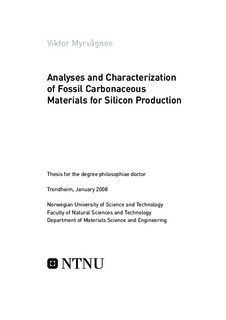| dc.description.abstract | Production of high silicon alloys is carried out in submerged arc furnaces by reduction of silicon bearing oxides (typically quartz) with carbon materials. Carbonaceous materials like coal, coke, charcoal and woodchips are commonly used as reduction materials in the process. Primarily based on historical prices of charcoal compared to fossil reduction materials, the Norwegian Ferroalloy Industry has mostly been using coal and coke (char) as the source of carbon. From a process point of view, the most important role of the carbonaceous material is to react with SiO gas to produce SiC. The ability of the reduction materials to react with SiO gas can be measured and the value is recognized as the reactivity of the carbon source. Reactivity is one of the most important parameters in the smelting process and is commonly acknowledged to strongly affect both productivity and specific energy consumption. The main objectives of this work has been to establish methods to characterize the material properties of fossil carbonaceous reduction materials used in the silicon process and to evaluated how these properties affect the reactivity towards SiO gas.
In order to accomplish these objectives, three run of mine (ROM) single seam coals which are particularly well suited for ferroalloy production were selected. Two Carboniferous coals from USA (Blue Gem) and Poland (Staszic) with similar rank, but significantly different composition as well as a Permian coal from Australia (Peak Downs) have been characterized by chemical- and petrographical methods. Blue Gem is a homogeneous coal, low in mineral inclusions and macerals of the inertinite group and determined to have a random vitrinite reflectance of 0.71 %. Staszic has a similar reflectance of vitrinite (0.72 %), but is determined to be a very inhomogeneous coal with both inertinite macerals and minerals embedded in the vitrinite matrix. Peak Downs has a random reflectance of vitrinite of 1.32 % and is hence the coal sample of highest rank. The highest amount of ash has been analyzed in this sample (11.6 %) and morphological studies of the sample revealed numerous clastic quartz inclusions throughout the coal matrix.
As constituents (macerals and minerals) in coal act differently upon carbonization, the ROM coals have been separated into different density fractions in order to obtain fractions with varying composition. Density fractions of the same coals proved to have significantly different petrographic composition, but were to some degree dependant upon the heterogeneity of the ROM coals.
The coals were carbonized according to a procedure simulating conditions the coals experience when charged to an industrial furnace. Both structure and texture of the resultant chars have been thoroughly examined. Petrographic examinations have been used to find the ratio of filler- and binder phase carbon forms in the carbonized samples Generally, the correlation between fusible and infusible macerals in the coal samples agreed well with the ratio of binder- and filler phase carbon forms in the chars. A high amount of depositional carbons were however quantified in the Blue Gem sample which is due to a combination of carbonization procedure and nature of the coal sample.
Reactivity of the carbonized samples towards SiO gas was assessed by the SINTEF SiO reactivity procedure. To quantify the degree of conversion, a combination of weight increase of the carbon material following reaction with SiO gas and etrographic examinations of the reacted samples was used.
Results from the SINTEF test did reveal that Peak Downs was the most reactive material of the tested samples, and it was not possible to differentiate between the density fractions. The reason for the observed behavior of Peak Downs is due to the abundant quartz inclusions in the coal matrix. These inclusions will react with carbon at the reaction temperature of 1650ºC to produce SiC and CO. In addition, the reaction will increase porosity and surface area of the material thus contributing to easier access for reacting gases which in turn will result in an increased reactivity and degree of conversion. Petrographic examinations of the reacted samples did in fact conclude with a degree of conversion close to 100 %.
Both density fractions of Blue Gem came out with similar reactivity values from the SINTEF test, and are termed intermediate of the tested materials. Blue Gem is a homogeneous coal, and there were no significant differences with regard to the petrographic composition of the density fractions. The effect of maceral composition on the reactivity towards SiO gas was thus hard to evaluate based on these samples. A degree of conversion between 80 – 90 % is estimated for the Blue Gem samples.
Staszic has been characterized as an inhomogeneous coal and the highest amount of infusible macerals and minerals are identified in the heaviest density fraction. The SINTEF SiO reactivity test revealed that there was a significant difference in reactivity between the two fractions. The highest density fraction of Staszic is the least reactive of all the tested materials and has a R10 corrected value more than 40 % higher than the lowest density fraction. As both fractions are of identical rank, the observed reactivity difference has to be caused by the higher amount of filler phase in the highest density fraction. The higher amount of filler phase did not affect the degree of conversion as values between 85 – 95 % was estimated for the Staszic samples.
Petrographic analyses have been extensively used throughout this work to characterize coal, carbonized coals and finally reacted samples. In order to fully understand the complexity of the coal samples, a combination of standard maceral analyses, non-maceral analyses and morphological studies is recommended. Petrographic analyses of the carbonized samples can give valuable information about the carbonization procedure and has in this work revealed massive formation of depositional carbon in the Blue Gem samples. Studies of the reacted samples under a petrographic microscope can render information about degree of conversion as well as which carbon forms are most reactive to SiO gas and preferential areas for condensation reactions. | nb_NO |
